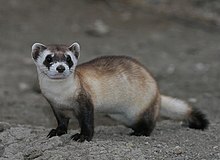Black-footed ferret
The black-footed ferret (Mustela nigripes), is a type of weasel. It is also called the American polecat or prairie dog hunter. It is native to central North America. It is an endangered species.[2]
| Black-footed ferret | |
|---|---|

| |
| Scientific classification | |
| Domain: | Eukaryota |
| Kingdom: | Animalia |
| Phylum: | Chordata |
| Class: | Mammalia |
| Order: | Carnivora |
| Family: | Mustelidae |
| Genus: | Mustela |
| Species: | M. nigripes
|
| Binomial name | |
| Mustela nigripes | |

| |
| Black-footed ferret range (three small areas on US territory) | |
Description
changeThe black-footed ferret has a long, slender body with black lines on the feet, ears, parts of the face and its tail. The neck is long and the legs short. The toes have sharp claws. The top and bottom of the feet are covered with hair, even to the soles. The fur on its feet hides the claws.[3]
Males are 500–533 millimetres (19.7–21.0 in) long. Females are usually 10% smaller than males. It weighs 650–1,400 grams (1.43–3.09 lb).[4][5]
Distribution and Habitat
changeBefore, the black-footed ferret's range was from southern Alberta and southern Saskatchewan south to Texas, New Mexico, and Arizona.[4] In 2007, the only known wild black-footed ferret population was found in the western Bighorn Basin near Meeteetse, Wyoming.[6][7][8] Since 1990, black-footed ferrets have been reintroduced into the following places: Shirley Basin, Wyoming; UL Bend National Wildlife Refuge and Fort Belknap Indian Reservation, Montana; Conata Basin/Badlands, Buffalo Gap National Grassland, and the Cheyenne River Sioux Reservation in South Dakota; Aubrey Valley, Arizona; Rocky Mountain Arsenal National Wildlife Refuge and Wolf Creek in Colorado; Coyote Basin, and Grasslands National Park, Canada.[9][10]
Before, the black-footed ferret lived in lots of habitats prairies with short grass, prairies with different types of grasses, desert grassland, shrub steppe, sagebrush steppe, mountain grassland, and semi-arid grassland.[8][4] Black-footed ferrets use the burrows of prairie dog to raise their young ones, stay away from predators, and to keep themselves warm.[11]
References
change- ↑ Belant, J., Biggins, D., Garelle, D., Griebel, R.G. & Hughes, J.P. (2015). Mustela nigripes. The IUCN Red List of Threatened Species 2015. doi:10.2305/IUCN.UK.2015-4.RLTS.T14020A45200314.en
- ↑ IUCN (2015-05-19). "Mustela nigripes: Belant, J., Biggins, D., Garelle, D., Griebel, R.G. & Hughes, J.P.: The IUCN Red List of Threatened Species 2015: e.T14020A45200314". doi:10.2305/iucn.uk.2015-4.rlts.t14020a45200314.en.
{{cite journal}}: Cite journal requires|journal=(help) - ↑ Audubon, John James; Bachman, John; Audubon, John Woodhouse (1851). The quadrupeds of North America. Duke University Libraries. New York, V.G. Audubon.
- ↑ 4.0 4.1 4.2 Hillman, Conrad N.; Clark, Tim W. (1980-04-15). "Mustela nigripes". Mammalian Species (126): 1–3. doi:10.2307/3503892. JSTOR 3503892.
- ↑ Briercheck, Ken; Csomos, Rebecca Ann. "Mustela nigripes (black-footed ferret)". Animal Diversity Web. Retrieved 2020-09-05.
- ↑ "Journals | BYU ScholarsArchive". scholarsarchive.byu.edu. Retrieved 2020-09-05.
- ↑ Richardson, Louise; Clark, Tim W.; Forrest, Steven C.; Campbell, Thomas M. (1987). "Winter Ecology of Black-footed Ferrets (Mustela nigripes) at Meeteetse, Wyoming". The American Midland Naturalist. 117 (2): 225–239. doi:10.2307/2425964. ISSN 0003-0031. JSTOR 2425964.
- ↑ 8.0 8.1 Forrest, Steven C.; Biggins, Dean E.; Richardson, Louise; Clark, Tim W.; Campbell, Thomas M.; Fagerstone, Kathleen A.; Thorne, E. Tom (1988-05-20). "Population Attributes for the Black-Footed Ferret (Mustela nigripes) at Meeteetse, Wyoming, 1981–1985". Journal of Mammalogy. 69 (2): 261–273. doi:10.2307/1381377. ISSN 0022-2372. JSTOR 1381377.
- ↑ "South Dakota Ecological Services Field Office: Black-footed Ferret". www.fws.gov. Archived from the original on 2017-07-05. Retrieved 2020-09-05.
- ↑ "Parks Canada - Grasslands National Park - Black-footed Ferret". 2013-02-08. Archived from the original on 2013-02-08. Retrieved 2020-09-05.
- ↑ Conrad, N.; Hillman (1968). Life history and ecology of the black-footed ferret in the wild.
